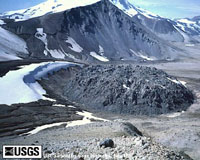| . |  |
. |
Blacksburg VA (SPX) Jan 05, 2010 Glaciers along the Gulf of Alaska are enriching stream and near shore marine ecosystems from a surprising source - ancient carbon contained in glacial runoff, researchers from four universities and the U.S. Forest Service report in the December 24, 2009, issue of the journal Nature. In spring 2008, Eran Hood, associate professor of hydrology with the Environmental Science Program at the University of Alaska Southeast, set out to measure the nutrients that reach the gulf from five glaciated watersheds he can drive to from his Juneau office. "We don't currently have much information about how runoff from glaciers may be contributing to productivity in downstream marine ecosystems. This is a particularly critical question given the rate at which glaciers along the Gulf of Alaska are thinning and receding" said Hood. Hood then asked former graduate school colleague Durelle Scott, now an assistant professor of biological systems engineering at Virginia Tech, to help analyze the organic matter and nutrient (nitrogen and phosphorus) loads being exported from the Juneau-area study watersheds. "Because there are few reports of nutrient yields from glacial watersheds, Eran and I decided to compare the result from a non-glacial watershed with those of a watershed partially covered by a glacier and a watershed fully covered by a glacier," said Scott. Hood and Scott's initial findings, reported in the September 2008 issue of the journal Nature Geoscience, presented something of a mystery. As might be expected, there is more organic matter from a forested watershed than from a fully or partially glacier-covered watershed. With soil development, organic matter is transported from the landscape during runoff events. However, there was still a considerable amount of organic carbon exported from the glaciated landscape. How can a glacier be a source of the organic carbon? His curiosity peeked, in spring 2009, Hood's Ph.D. student, Jason Fellman, collected samples from 11 watersheds along the Gulf of Alaska from Juneau to the Kenai Peninsula. The samples were analyzed to determine the age, source, and biodegradability of organic matter derived from glacier inputs. "We found that the more glacier there is in the watershed, the more carbon is bioavailable. And the higher the percentage of glacier coverage, the older the organic material is - up to 4,000 years old," said Scott. Hood and Scott hypothesize that forests that lived along the Gulf of Alaska between 2,500 to 7,000 years ago were covered by glaciers, and this organic matter is now coming out. "The organic matter in heavily glaciated watersheds is labile, like sugar. Microorganisms appear to be metabolizing ancient carbon and as the microorganisms die and decompose, biodegradable dissolved organic carbon is being flushed out with the glacier melt," said Scott. How much? "Our findings suggest that runoff from glaciers may be a quantitatively important source of bioavailable organic carbon for coastal ecosystems in the Gulf of Alaska and, as a result, future changes in glacier extent may impact the food webs in this region that support some of the most productive fisheries in the United States," said Hood. The article, "Glaciers as a source of ancient, labile organic matter to the marine environment," was authored by Hood; Fellman, now at the Institute of Arctic Biology at the University of Alaska Fairbanks; Robert G.M. Spencer and Peter J. Hernes of the Department of Land, Air and Water Resources at the University of California Davis; Rick Edwards and David D'Amore of the Pacific Northwest Research Station of the U.S.D.A. Forest Service in Juneau, and Scott.
Share This Article With Planet Earth
Related Links Virginia Tech Beyond the Ice Age
 Melting glacial ice harms food chain
Melting glacial ice harms food chain(UPI) Junau, Alaska (UPI) Dec 28, 2009 Melting glacial ice in the Gulf of Alaska affects the marine food chain from microbes to the fish that feed on them, scientists said. The organic matter of the gulf's watersheds is "remarkably" biologically active and is likely to decrease as glacial ice melts and the biomass is not replenished, said Rick Edwards, an aquatic ecologist with the Pacific Northwest Station in Juneau, Alaska ... read more |
|
| The content herein, unless otherwise known to be public domain, are Copyright 1995-2009 - SpaceDaily. AFP and UPI Wire Stories are copyright Agence France-Presse and United Press International. ESA Portal Reports are copyright European Space Agency. All NASA sourced material is public domain. Additional copyrights may apply in whole or part to other bona fide parties. Advertising does not imply endorsement,agreement or approval of any opinions, statements or information provided by SpaceDaily on any Web page published or hosted by SpaceDaily. Privacy Statement |